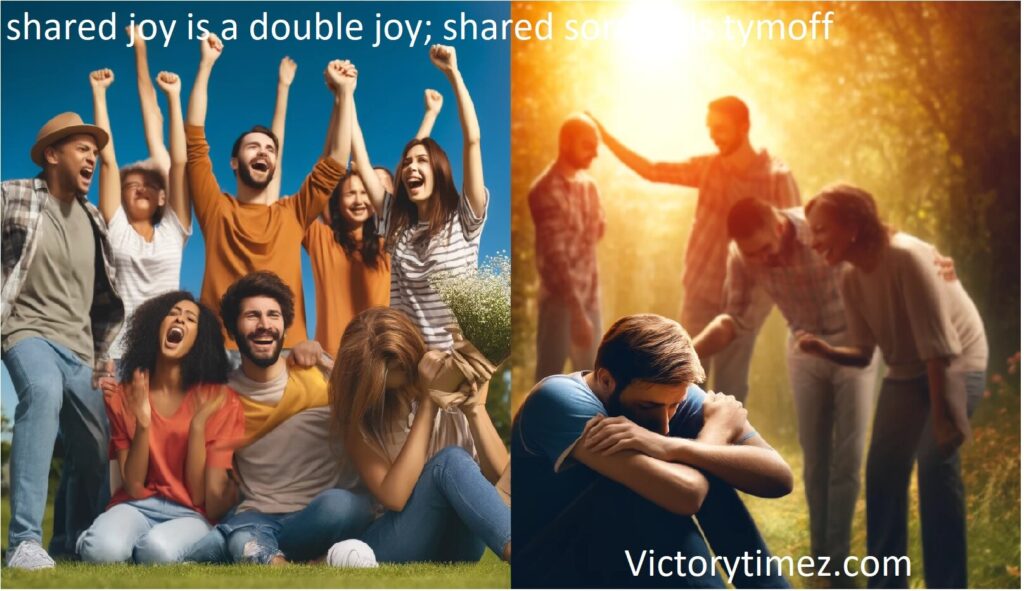
shared joy is a double joy; shared sorrow is tymoff In the tapestry of human experiences, joy and sorrow are two threads that weave through our lives, shaping our emotions and relationships. The saying “Shared joy is a double joy; shared sorrow is half a sorrow” encapsulates the profound impact of sharing these emotions with others. This article delves into the essence of this timeless adage, exploring how sharing both happiness and grief affects our well-being and relationships.
Introduction of shared joy is a double joy; shared sorrow is tymoff
Understanding the power of shared experiences can transform how we approach our interactions with others. This article will explore the nuances of this saying and how it applies to our daily lives.
The Nature of Joy
What is Joy?
shared joy is a double joy; shared sorrow is tymoff is an intense, often spontaneous feeling of happiness and contentment. It’s the kind of emotion that makes you feel like you’re floating on cloud nine, whether it’s due to personal achievements, moments of connection with others, or simply experiencing life’s wonders.
The Benefits of Joy
Sharing joy amplifies its benefits. When we share our happiness, we not only enhance our own experience but also contribute to the joy of others. This mutual exchange creates a ripple effect, fostering a positive environment that can lead to stronger relationships and a more supportive community.
The Impact of Sharing Joy
Strengthening Relationships
When we share shared joy is a double joy; shared sorrow is tymoff with others, it strengthens our bonds. Celebrations, whether they are personal milestones or collective achievements, become more meaningful when shared. This shared happiness fosters a sense of camaraderie and unity.
Enhancing Personal Happiness
Sharing joy doesn’t just benefit those around us; it also reinforces our own happiness. The act of expressing and celebrating positive emotions can increase our sense of fulfillment and contentment.
Creating Positive Feedback Loops
The shared joy is a double joy; shared sorrow is tymoff we share often comes back to us, creating a cycle of positivity. This feedback loop helps to sustain high levels of happiness and strengthens our social connections.
Understanding Sorrow
What is Sorrow?
Sorrow is a deep, often overwhelming feeling of sadness or distress. It can arise from personal loss, disappointment, or any situation that challenges our sense of well-being and security.
The Effects of Sorrow
Sorrow can be isolating, but sharing it with others can significantly alleviate its weight. The act of expressing and discussing our grief can provide comfort and understanding, reducing the sense of loneliness that often accompanies sorrow. shared joy is a double joy; shared sorrow is tymoff
The Impact of Sharing Sorrow
Reducing the Burden
When we shared joy is a double joy; shared sorrow is tymoff our sorrow with others, we often find that the burden becomes lighter. Friends and family can offer support, empathy, and practical help, which can make a significant difference in our ability to cope with difficult situations.
Fostering Empathy and Compassion
Sharing sorrow helps build empathy and compassion. It allows others to connect with our experiences on a deeper level and fosters a sense of mutual understanding and support.
Strengthening Social Bonds
Just as sharing joy strengthens relationships, sharing sorrow can also enhance the bonds we have with others. The vulnerability that comes with sharing our grief often leads to deeper, more meaningful connections.
Practical Ways to Share Joy and Sorrow

Celebrating Together
Engage in celebrations with friends and family. Whether it’s a personal achievement or a collective event, including others in your joy makes the experience richer and more rewarding.
Offering Support During Tough Times
Be present for others in their times of need. Offering a listening ear, a shoulder to cry on, or practical assistance can make a significant difference in someone’s life.
Communicating Openly
Practice open communication about your feelings. Whether you’re sharing joy or shared joy is a double joy; shared sorrow is tymoff, expressing your emotions honestly can lead to stronger, more supportive relationships.
The Science Behind Shared Emotions
Psychological Perspectives
Research in psychology shows that sharing emotions can enhance our mental well-being. Social support is linked to lower levels of stress and better coping strategies, highlighting the benefits of sharing both shared joy is a double joy; shared sorrow is tymoff.
Neurological Insights
Studies indicate that social interactions involving shared emotions activate areas of the brain associated with pleasure and empathy. This neurological response underscores the profound impact of sharing our experiences with others. shared joy is a double joy; shared sorrow is tymoff
Overcoming Challenges in Sharing Emotions
Addressing Stigma
Sometimes, societal stigma can make it difficult to share emotions, especially sorrow. Overcoming this stigma involves creating open, accepting environments where people feel safe to express their feelings.
Navigating Personal Boundaries
While sharing emotions is important, it’s also crucial to respect personal boundaries. Understanding when and how to share, and being mindful of others’ comfort levels, ensures that emotional exchanges are healthy and supportive.
The Role of Technology in Sharing Emotions
Social Media and Emotional Sharing
Technology and social media provide platforms for sharing both shared joy is a double joy; shared sorrow is tymoff. While these platforms can facilitate connections, it’s essential to use them mindfully to maintain genuine and meaningful interactions.
Virtual Support Networks
Online support groups and communities offer spaces for sharing experiences and finding empathy. These networks can be especially valuable for those who may not have immediate support systems in their physical environment. shared joy is a double joy; shared sorrow is tymoff
The Cultural Perspectives on Shared Emotions
Variations Across Cultures
Different cultures have unique approaches to sharing emotions. Understanding these cultural variations can enhance our ability to connect with others and appreciate diverse ways of expressing joy and sorrow.
Global Practices
Exploring global practices related to emotional sharing can provide insights into how different societies handle joy and sorrow, offering valuable lessons for fostering empathy and connection.
Personal Stories and Anecdotes
Real-Life Examples
Personal stories of how sharing shared joy is a double joy; shared sorrow is tymoff has impacted individuals’ lives can illustrate the power of this adage in action. These anecdotes provide relatable examples of the emotional benefits of sharing experiences.
Lessons Learned
Reflecting on these stories can offer practical insights and inspiration for how we can incorporate these principles into our own lives.
Conclusion
The saying shared joy is a double joy; shared sorrow is tymoff is a double joy; shared sorrow is half a sorrow” highlights the transformative power of sharing our emotions with others. By celebrating our joys together and supporting one another through sorrows, we enhance our well-being and strengthen our relationships. Embracing this principle can lead to a more connected and supportive community, where happiness and grief are shared and understood.
FAQs
How can sharing joy improve my personal happiness?
Sharing joy amplifies the positive feelings and reinforces your own happiness through mutual celebration and support.
What are some effective ways to share sorrow with others?
Communicating openly about your feelings, seeking support from friends and family, and participating in supportive communities can help alleviate the burden of sorrow.
How can technology aid in sharing emotions?
Technology, through social media and virtual support networks, provides platforms for expressing and receiving support for both joy and sorrow, although it should be used mindfully.
Are there cultural differences in how emotions are shared?
Yes, different cultures have varied practices and norms regarding emotional expression, influencing how joy and sorrow are shared and perceived.
How can I overcome the stigma associated with sharing sorrow?
Creating open and accepting environments, practicing empathy, and fostering honest communication can help overcome societal stigma and encourage the sharing of sorrow.